engine YAMAHA PW50 2021 User Guide
[x] Cancel search | Manufacturer: YAMAHA, Model Year: 2021, Model line: PW50, Model: YAMAHA PW50 2021Pages: 82, PDF Size: 1.87 MB
Page 38 of 82
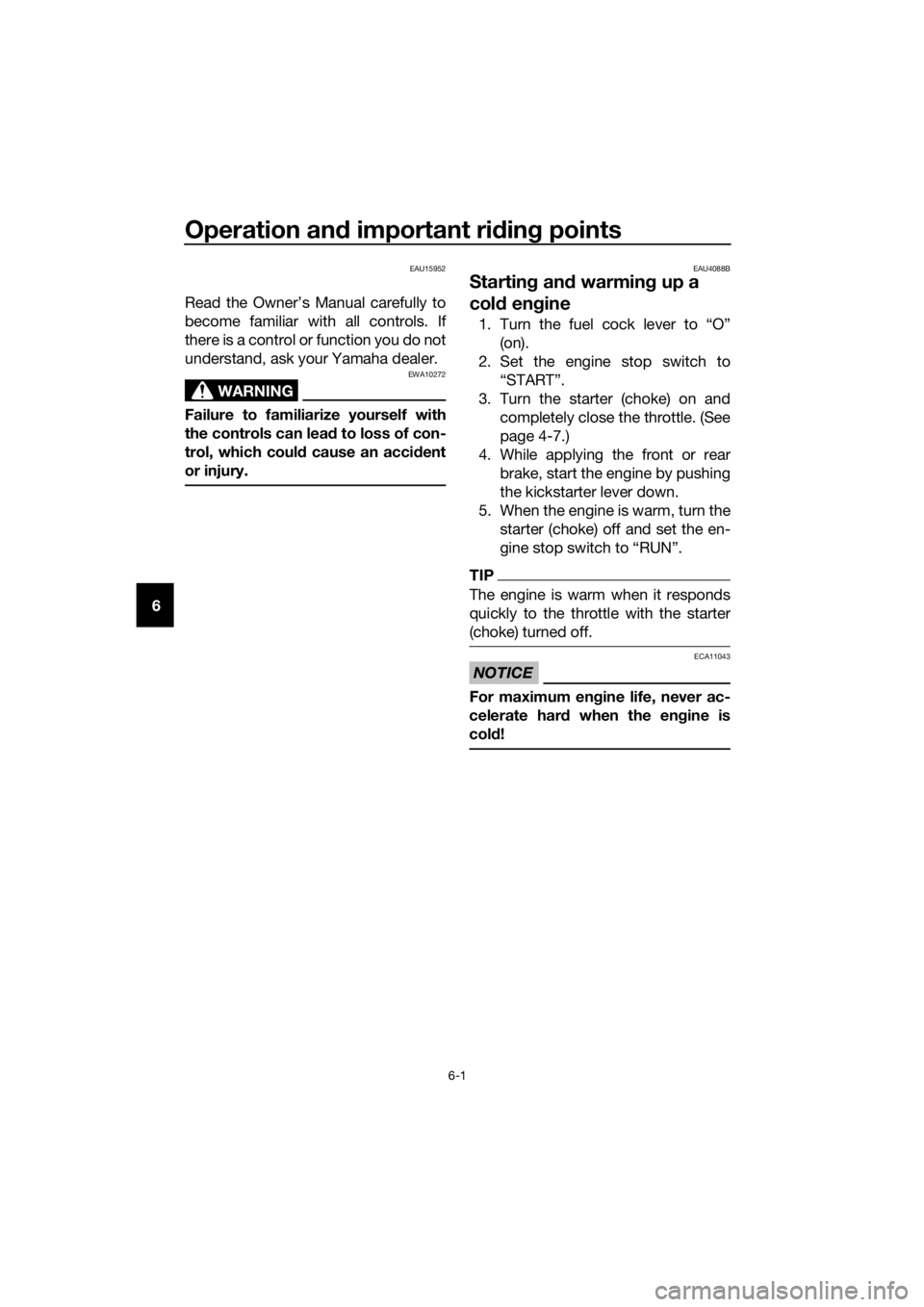
Operation and important rid ing points
6-1
6
EAU15952
Read the Owner’s Manual carefully to
become familiar with all controls. If
there is a control or function you do not
understand, ask your Yamaha dealer.
WARNING
EWA10272
Failure to familiarize yourself with
the controls can lead to loss of con-
trol, which coul d cause an acci dent
or injury.
EAU4088B
Startin g an d warming up a
col d en gine
1. Turn the fuel cock lever to “O”
(on).
2. Set the engine stop switch to “START”.
3. Turn the starter (choke) on and completely close the throttle. (See
page 4-7.)
4. While applying the front or rear brake, start the engine by pushing
the kickstarter lever down.
5. When the engine is warm, turn the starter (choke) off and set the en-
gine stop switch to “RUN”.
TIP
The engine is warm when it responds
quickly to the throttle with the starter
(choke) turned off.
NOTICE
ECA11043
For maximum eng ine life, never ac-
celerate har d when the en gine is
col d!
U2SA87E0.book Page 1 Monday, April 6, 2020 3:00 PM
Page 39 of 82

Operation and important ri din g points
6-2
6
EAU16661
Startin g a warm en gine
Follow the same procedure as for
starting a cold engine with the excep-
tion that the starter (choke) is not re-
quired when the engine is warm.
Instead, start the engine with the throt-
tle slightly open.
TIP
If the engine does not start after sever-
al kicks, try again with the throttle 1/4
to 1/2 open.
EAU41004
Startin g off
1. While applying the rear brake le-
ver, push the motorcycle off the
centerstand.
2. Completely close the throttle.
3. Set the engine stop switch to “RUN”.
4. Check for oncoming off-road vehi- cles, release the rear brake lever,
and then slowly turn the throttle
grip in order to take off.
U2SA87E0.book Page 2 Monday, April 6, 2020 3:00 PM
Page 41 of 82

Operation and important ri din g points
6-4
6
EAU42031
En gine break-in
There is never a more important period
in the life of your engine than the first 5
hours of riding. It is also important to
accustom the rider to the motorcycle
during this time. Please read the fol-
lowing information carefully.
Since the engine is brand new, do not
put an excessive load on it for the first
5 hours of operation. The various parts
in the engine wear and polish them-
selves to the correct operating clear-
ances. During this period, prolonged
full-throttle operation or any condition
that might result in engine overheating
must be avoided. However, momen-
tary full-throttle operation under load
(i.e., two to three seconds maximum)
does not harm the engine. Each full-
throttle acceleration should be fol-
lowed with a substantial rest period for
the engine. To allow the engine to cool
down from the temporary buildup of
heat, cruise at a lower engine speed.
After the first 5 hours of operation,
thoroughly check the motorcycle for
loose parts, oil leakage and any other
problems. Be sure to inspect and make
adjustments thoroughly, especially ca-
bles. In addition, check all fittings and
fasteners for looseness, and tighten if
necessary.
NOTICE
ECA10271
If any en gine trou ble shoul d occur
d uring the en gine break-in perio d,
imme diately have a Yamaha d ealer
check the vehicle.
EAU40723
Parkin g
When parking, stop the engine, and
then turn the fuel cock lever to “S”
(stop).
WARNING
EWA10312
Since the en gine an d exhaust
system can become very hot,
park in a place where ped estri-
ans or chil dren are not likely to
touch them and b e burne d.
Do not park on a slope or on soft
groun d, otherwise the vehicle
may overturn, increasin g the
risk of a fuel leak an d fire.
Do not park near grass or other
flammab le materials which
mi ght catch fire.
U2SA87E0.book Page 4 Monday, April 6, 2020 3:00 PM
Page 43 of 82

Periodic maintenance an d a djustment
7-2
7
EAU17303
Emission controls not only function to
ensure cleaner air, but are also vital to
proper engine operation and maximum
performance. In the following periodic
maintenance charts, the services relat-
ed to emissions control are grouped
separately. These services require
specialized data, knowledge, and
equipment. Maintenance, replace-
ment, or repair of the emission control
devices and systems may be per-
formed by any repair establishment or
individual that is certified (if applicable).
Yamaha dealers are trained and equipped to perform these particular
services.
EAU17312
Owner’s tool kit
The service information included in this
manual and the tools provided in the
owner’s tool kit are intended to assist
you in the performance of preventive
maintenance and minor repairs. How-
ever, additional tools such as a torque
wrench may be necessary to perform
certain maintenance work correctly.
TIP
If you do not have the tools or experi-
ence required for a particular job, have
a Yamaha dealer perform it for you.
U2SA87E0.book Page 2 Monday, April 6, 2020 3:00 PM
Page 44 of 82

Periodic maintenance an d a djustment
7-3
7
EAU69180
Perio dic maintenance chart for the emission control system
TIP
Items marked with an asterisk should be performed by a Yamaha dealer as they
require special tools, data and technical skills.
4 *Carburetor Check engine idling speed and
starter operation.
Adjust if necessary.
Clean.
5 *Cylinder head and
exhaust system Check for leakage.
√
Tighten if necessary.
Decarbonize if necessary.
6
*Spark arrester Clean.√
NO. ITEM CHECK OR MAINTENANCE JOB
1 month3 months
6 months
6 months12 months
1
*Fuel line Check fuel hoses for cracks or
damage.√√√ √
√√√ √
√√
√
√
√√
√
√
√√
√ Replace if necessary.
2Spark plug Check condition.
Adjust gap and clean.
Replace if necessary.
3Air filter element
Clean with solvent.
Replace if necessary.
THEREAFTER
EVERYINITIAL
U2SA87E0.book Page 3 Monday, April 6, 2020 3:00 PM
Page 47 of 82
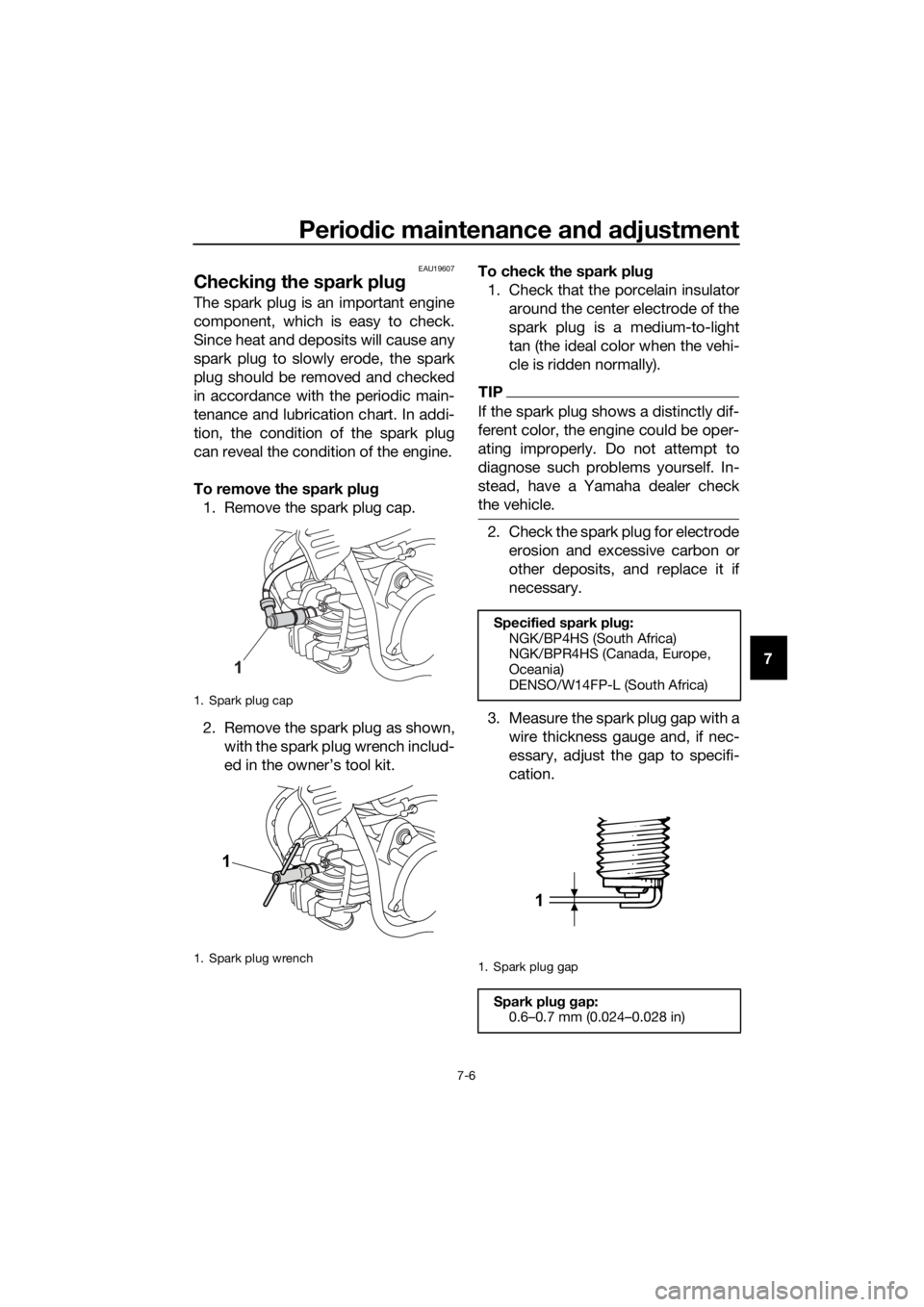
Periodic maintenance an d a djustment
7-6
7
EAU19607
Checkin g the spark plu g
The spark plug is an important engine
component, which is easy to check.
Since heat and deposits will cause any
spark plug to slowly erode, the spark
plug should be removed and checked
in accordance with the periodic main-
tenance and lubrication chart. In addi-
tion, the condition of the spark plug
can reveal the condition of the engine.
To remove the spark plu g
1. Remove the spark plug cap.
2. Remove the spark plug as shown, with the spark plug wrench includ-
ed in the owner’s tool kit. To check the spark plu
g
1. Check that the porcelain insulator around the center electrode of the
spark plug is a medium-to-light
tan (the ideal color when the vehi-
cle is ridden normally).
TIP
If the spark plug shows a distinctly dif-
ferent color, the engine could be oper-
ating improperly. Do not attempt to
diagnose such problems yourself. In-
stead, have a Yamaha dealer check
the vehicle.
2. Check the spark plug for electrodeerosion and excessive carbon or
other deposits, and replace it if
necessary.
3. Measure the spark plug gap with a wire thickness gauge and, if nec-
essary, adjust the gap to specifi-
cation.
1. Spark plug cap
1. Spark plug wrench
1
1
Specified spark plu g:
NGK/BP4HS (South Africa)
NGK/BPR4HS (Canada, Europe,
Oceania)
DENSO/W14FP-L (South Africa)
1. Spark plug gap
Spark plu g g ap:
0.6–0.7 mm (0.024–0.028 in)
1
U2SA87E0.book Page 6 Monday, April 6, 2020 3:00 PM
Page 48 of 82
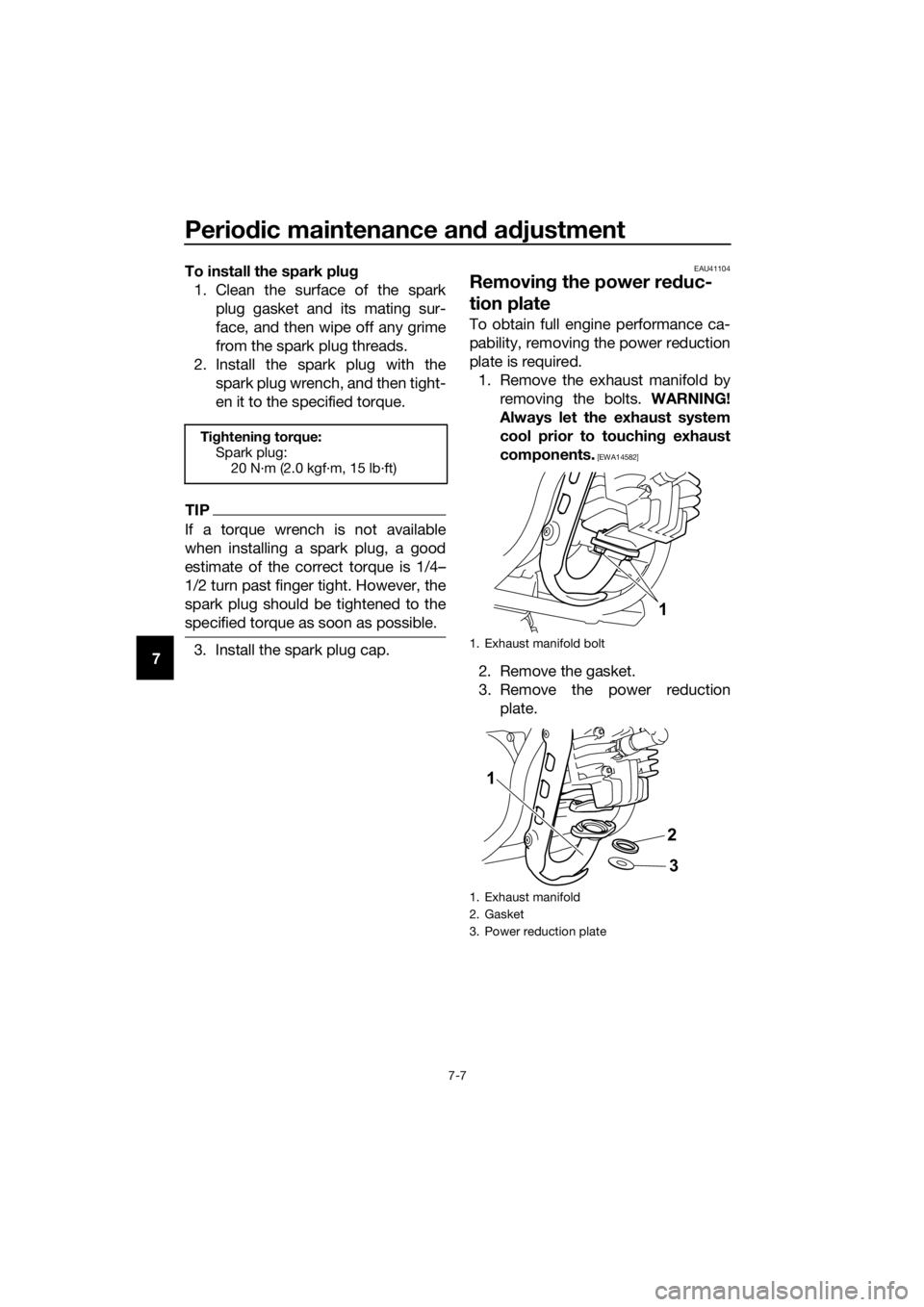
Periodic maintenance an d a djustment
7-7
7 To install the spark plu
g
1. Clean the surface of the spark plug gasket and its mating sur-
face, and then wipe off any grime
from the spark plug threads.
2. Install the spark plug with the spark plug wrench, and then tight-
en it to the specified torque.
TIP
If a torque wrench is not available
when installing a spark plug, a good
estimate of the correct torque is 1/4…
1/2 turn past finger tight. However, the
spark plug should be tightened to the
specified torque as soon as possible.
3. Install the spark plug cap.
EAU41104
Removin g the power re duc-
tion plate
To obtain full engine performance ca-
pability, removing the power reduction
plate is required.
1. Remove the exhaust manifold by removing the bolts. WARNING!
Always let the exhaust system
cool prior to touchin g exhaust
components.
[EWA14582]
2. Remove the gasket.
3. Remove the power reduction plate.
Tightenin g torque:
Spark plug: 20 N·m (2.0 kgf·m, 15 lb·ft)
1. Exhaust manifold bolt
1. Exhaust manifold
2. Gasket
3. Power reduction plate
1
1
2
3
U2SA87E0.book Page 7 Monday, April 6, 2020 3:00 PM
Page 49 of 82
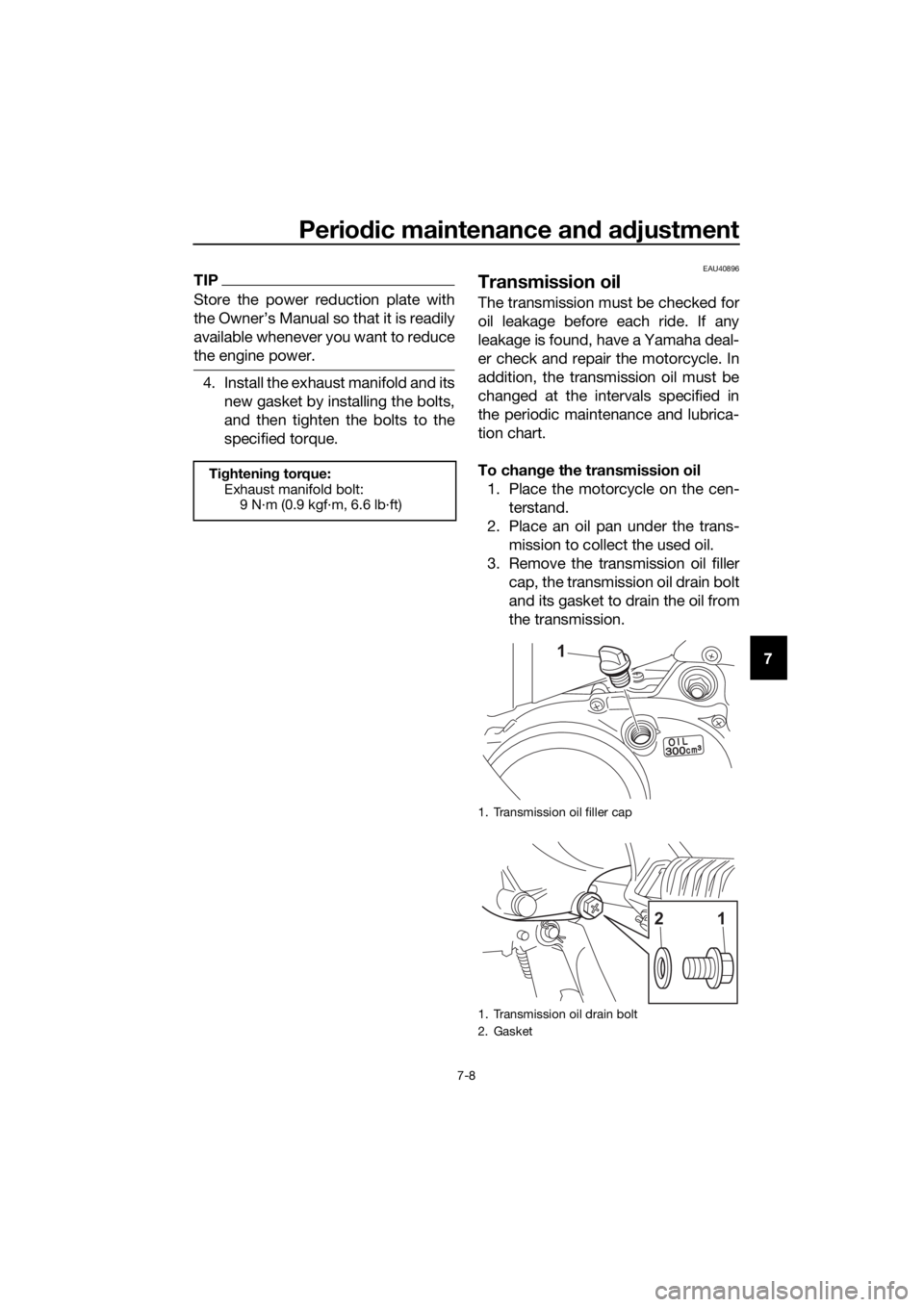
Periodic maintenance an d a djustment
7-8
7
TIP
Store the power reduction plate with
the Owner’s Manual so that it is readily
available whenever you want to reduce
the engine power.
4. Install the exhaust manifold and its
new gasket by installing the bolts,
and then tighten the bolts to the
specified torque.
EAU40896
Transmission oil
The transmission must be checked for
oil leakage before each ride. If any
leakage is found, have a Yamaha deal-
er check and repair the motorcycle. In
addition, the transmission oil must be
changed at the intervals specified in
the periodic maintenance and lubrica-
tion chart.
To chan ge the transmission oil
1. Place the motorcycle on the cen- terstand.
2. Place an oil pan under the trans- mission to collect the used oil.
3. Remove the transmission oil filler cap, the transmission oil drain bolt
and its gasket to drain the oil from
the transmission.
Tightening torque:
Exhaust manifold bolt: 9 N·m (0.9 kgf·m, 6.6 lb·ft)
1. Transmission oil filler cap
1. Transmission oil drain bolt
2. Gasket
1
12
U2SA87E0.book Page 8 Monday, April 6, 2020 3:00 PM
Page 50 of 82
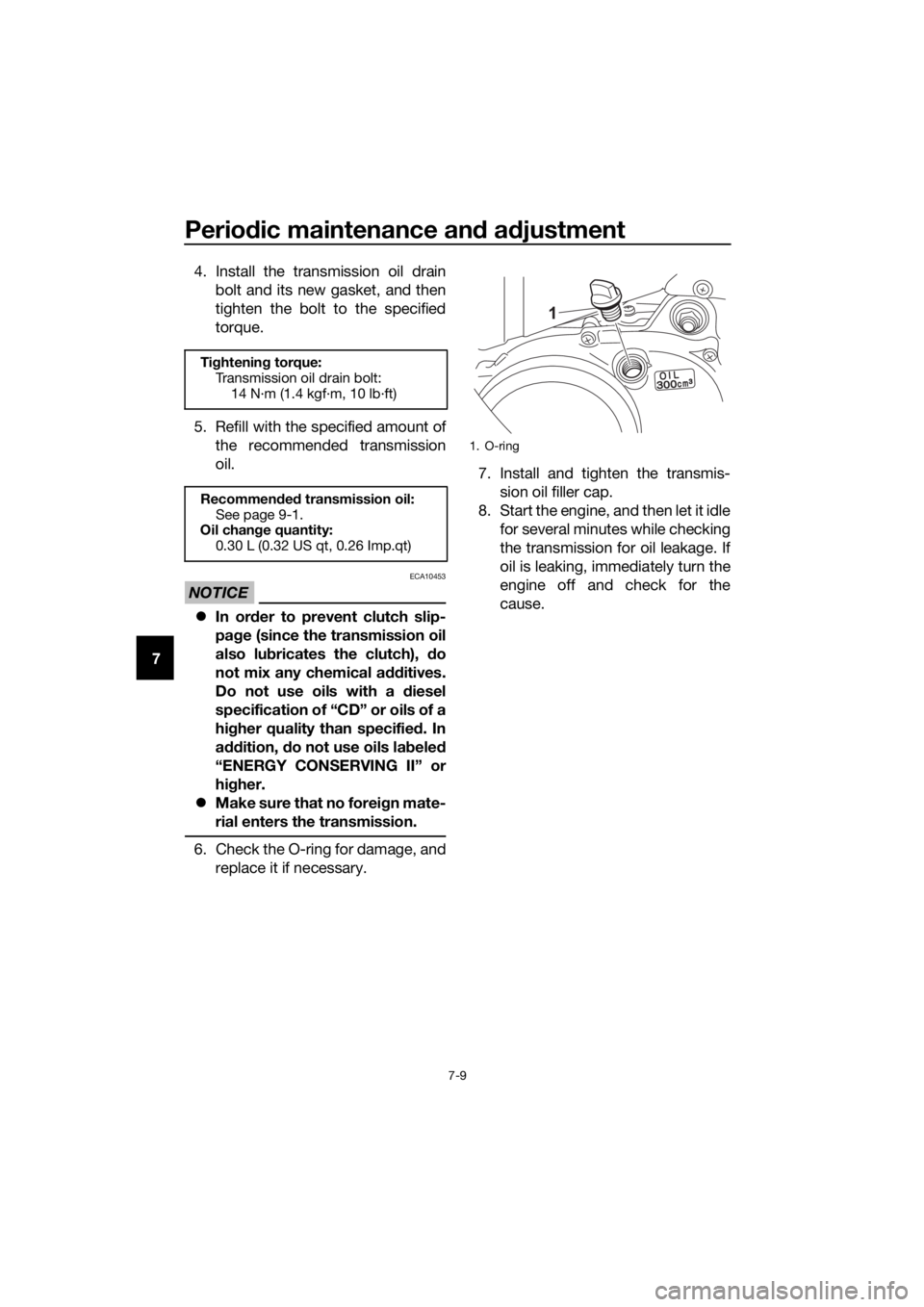
Periodic maintenance an d a djustment
7-9
7 4. Install the transmission oil drain
bolt and its new gasket, and then
tighten the bolt to the specified
torque.
5. Refill with the specified amount of the recommended transmission
oil.
NOTICE
ECA10453
In or der to prevent clutch slip-
pa ge (since the transmission oil
also lu bricates the clutch), d o
not mix any chemical additives.
Do not use oils with a diesel
specification of “CD” or oils of a
hi gher quality than specifie d. In
a ddition, do not use oils la bele d
“ENERGY CONSERVING II” or
hi gher.
Make sure that no forei gn mate-
rial enters the transmission.
6. Check the O-ring for damage, and replace it if necessary. 7. Install and tighten the transmis-
sion oil filler cap.
8. Start the engine, and then let it idle for several minutes while checking
the transmission for oil leakage. If
oil is leaking, immediately turn the
engine off and check for the
cause.
Tightenin g torque:
Transmission oil drain bolt: 14 N·m (1.4 kgf·m, 10 lb·ft)
Recommen ded transmission oil:
See page 9-1.
Oil chan ge quantity:
0.30 L (0.32 US qt, 0.26 Imp.qt)
1. O-ring
1
U2SA87E0.book Page 9 Monday, April 6, 2020 3:00 PM
Page 53 of 82
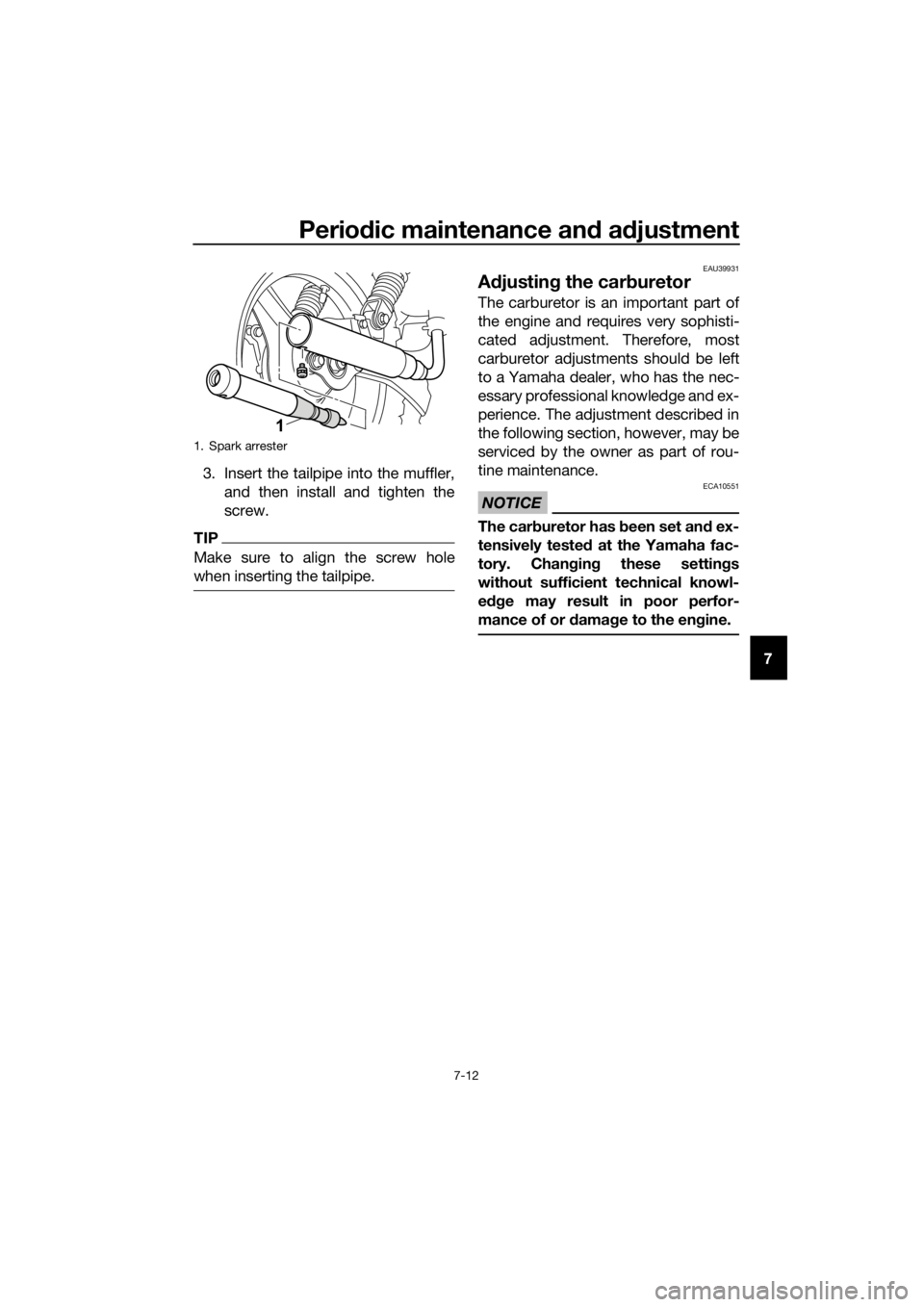
Periodic maintenance an d a djustment
7-12
7
3. Insert the tailpipe into the muffler,
and then install and tighten the
screw.
TIP
Make sure to align the screw hole
when inserting the tailpipe.
EAU39931
Adjustin g the car buretor
The carburetor is an important part of
the engine and requires very sophisti-
cated adjustment. Therefore, most
carburetor adjustments should be left
to a Yamaha dealer, who has the nec-
essary professional knowledge and ex-
perience. The adjustment described in
the following section, however, may be
serviced by the owner as part of rou-
tine maintenance.
NOTICE
ECA10551
The car buretor has b een set and ex-
tensively teste d at the Yamaha fac-
tory. Chan gin g these settin gs
without sufficient technical knowl-
e dge may result in poor perfor-
mance of or d amage to the en gine.
1. Spark arrester
1
U2SA87E0.book Page 12 Monday, April 6, 2020 3:00 PM